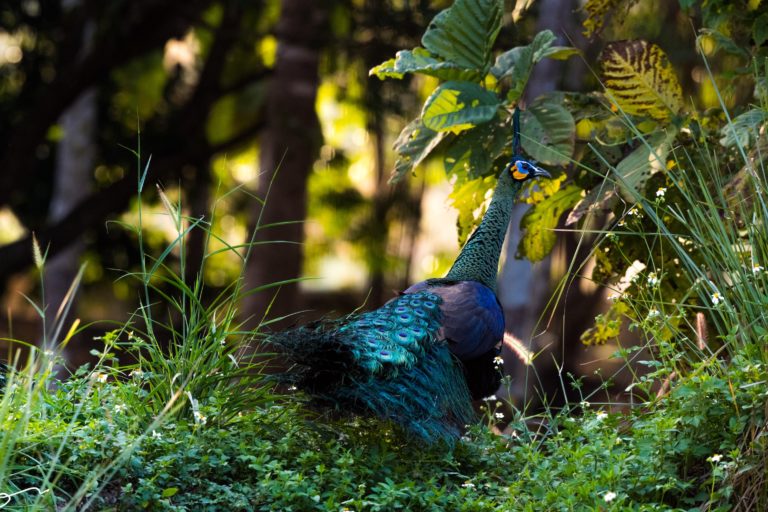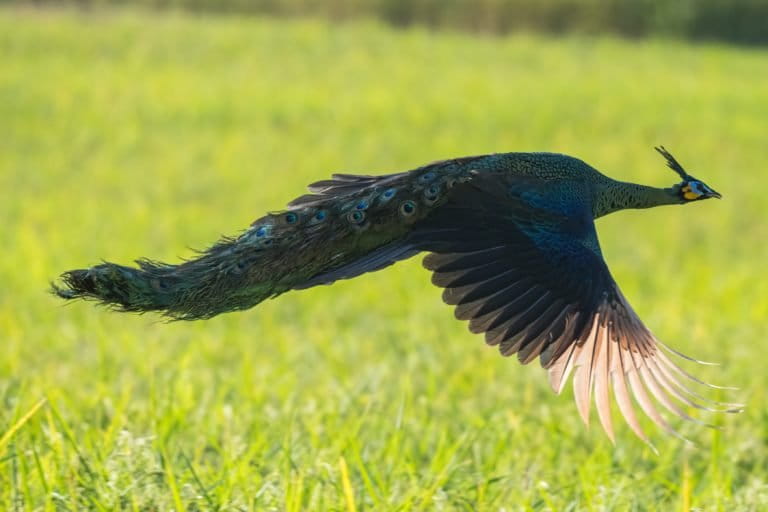- Green peafowl (Pavo muticus) are thought to occur across 16% of their former range in mainland Southeast Asia, confined to a handful of isolated forests by a legacy of forest habitat loss, overhunting, and conflict with humans.
- A new study documents a thriving population in a network of four protected areas in Phayao province in northern Thailand; it is the largest population yet recorded in mainland Southeast Asia.
- While the green peafowl population in Phayao’s protected forests appears to be thriving, the new study spotlights growing conflict with farmers as peafowl venture into adjacent cropland to raid rice and maize.
- Local partners are leveraging the green peafowl’s popularity with bird-watchers to improve local perceptions of the birds.
CHIANG MAI, Thailand — Once widespread across Southeast Asia, from Java to southern China, green peafowl (Pavo muticus) have vanished from much of the region over the past few decades, due to forest habitat loss, overhunting and persecution following conflict with farmers. The endangered species is only present in 16% of its former range in mainland Southeast Asia, and is largely confined to a handful of isolated forests in Cambodia, Laos, Myanmar, Thailand and Vietnam, according to a 2019 study.
Now, a thriving population has been documented in a network of four protected areas in Phayao province in northern Thailand. Researchers say the findings, published in June in Global Ecology and Conservation, represent the largest population of green peafowl yet recorded in mainland Southeast Asia.
Green peafowl are perhaps less famous than their blue relatives, Indian peafowl (Pavo cristatus), which are frequently kept in temples, public parks and private grounds around the world, due to their resplendent feathers and the comparative ease of caring for them in captivity. Male green peafowl sport similarly impressive tail trains, which they use during courtship rituals.

Between January and April 2018, a team led by researchers from King Mongkut’s University of Technology, Thonburi, surveyed an area spanning 1,500 square kilometers (580 square miles), comprising Tub Phaya Lor Wildlife non-hunting area, Wiang Lor Wildlife Sanctuary, Doi Phu Nang National Park, Mae Yom National Park, and surrounding agricultural land. Based on 1,615 bird detections, the researchers calculated an average of 15.82 calling green peafowl males per square kilometer (40.97 calling males per square mile).
“They’re at a very high density, much higher than what we have found in many other places,” study co-author Tommaso Savini, a conservation biologist at King Mongkut’s University of Technology, Thonburi, told Mongabay. By comparison, surveys in other parts of Thailand as well as Myanmar, Vietnam and Cambodia estimated local population densities in the range of 0.25 to 11.34 calling males per km2 (0.65 to 29.37 calling males per mi2).
While the success of the Phayao peafowl population is good news, the researchers observed that peafowl often venture out of the forest to raid farmland that abuts the protected forests. The resulting conflict between peafowl and farmers “generates all kinds of problems that in the long term could result in a decline of the population,” Savini said.

Expanding populations
According to Savini, green peafowl populations in western Thailand, particularly in the Huai Kha Khaeng Wildlife Sanctuary, have expanded under the protection of anti-poaching patrols aiming to preserve tigers and their prey. But much less was known about the species’ status in forests in northern Thailand.
Although protected forests in Phayao are now patrolled by park rangers, they suffered severely from hunting and agricultural encroachment in the past. As a result, large carnivores like tigers and leopards and many ungulate species have been extirpated from northern forests. Savini says the lack of predators and competitors may have led to the booming green peafowl population.
Ghan Saridnirun, postdoctoral candidate at King Mongkut’s University of Technology, Thonburi, and lead author of the study, said local belief systems may also have had a role in protecting green peafowl. The birds are locally revered as the companions of Buddhist monks, so causing them harm is strictly taboo. As a result, they are rarely hunted for their feathers as they are in other parts of their range, and collecting their eggs to sell in the pet trade is both illegal and culturally shunned.
The researchers found that the peafowl rely on forest areas with a rich understory of shrubs and saplings, including dry dipterocarp, mixed deciduous and mixed pine forest. Although density of peafowl was highest in forest areas farthest from human settlements, they were frequently observed in the surrounding agricultural fields, particularly during the breeding season, which coincides with the ripening of rice and maize.
Saridnirun said courtship displays at the edge of the forest are frequently derailed by the irresistible allure of a good meal. “The males need open ground to display to the females, but when the female sees the agriculture, they see it is an easy meal and they will both go into the field to eat.”

Growing conflict in frontier zones
This opportunistic crop raiding stirs up threats to the species’ long-term survival. Farmers who perceive the peafowl as pests often retaliate by poisoning the birds, Saridnirun said, or by stationing guard dogs in fields to scare them away.
With their cumbersome tail feathers, green peafowl are easy prey for packs of feral dogs patrolling open cropland or forest edges. “We found evidence of 16 to 20 green peafowl killed by dogs in one year,” Saridnirun said. “Six of these by one pack of dogs.”
For now, the birds are most in danger when they venture into open cropland, while the lack of top predators in Phayao’s forests means there is no check on feral dog populations hunting within the forest interior. “If the peafowl suffer from dog hunting in the agricultural landscape, that’s one issue; but if dogs start to go deep into the forest, that’s another problem,” Savini said. “Most likely, the next management step will be how to work with the local community at the farm level in order to reduce the possibility of human-wildlife conflict.”
Another threat is direct loss of habitat through dry-season forest fires. The dry forests throughout the region are a tinderbox that can be sparked by campfires, leaf-litter incineration to stimulate mushroom growth, and even by lightning strikes.
Just as fire is a feature of peafowls’ lives, it was a facet of the research surveys, with Saridnirun’s team sometimes having to help extinguish fires. “We got stuck in the forest for around nine hours once because everywhere around us was burning. You can walk for many hours with only ash around you and the smell of the smoke. It feels like the middle of the night.”
Despite the habitat devastation caused by fires, the green peafowl have learned to adapt. “We found that sometimes the mother [peafowl] would bring her chicks to the fire line to collect the insects,” Saridnirun said. “And they seem to know how to avoid the fire and go into other areas, then once the fire is extinguished, they return. From our camera traps we saw that they are one of the first species to come back into the forest after fire.”

Thattaya Bidayabha, executive director of the Bird Conservation Society of Thailand, said the new study “provides valuable new knowledge” about green peafowl in northern Thailand. She said the species has also been recorded outside of protected areas in neighboring provinces, including Chiang Rai, Phrae and Nan. In Bidayabha’s view, the best way to ensure forest corridors between subpopulations persist is to raise awareness of biodiversity protection and sustainable practices among local communities.
Aside from habitat loss and conflict with humans, Bidayabha said a serious concern for green peafowl in Thailand is the risk of hybridization with escapee Indian peafowl, which could ultimately erode the species’ genetic diversity.
Philip Round, an ornithologist from Mahidol University, echoed Bidayabha’s concerns: “Hybridization would be a total disaster.” Hybrid birds look more or less like the green peafowl, so it is very difficult to tell them apart. Round said it’s vital that Indian peafowl captive-breeding programs within the natural range of green peafowl do not release birds into the wild.

A focal species for ecotourism
While the green peafowl population in Phayao’s protected forests appears to be thriving, the new study spotlights the growing conflict with farmers. The authors say programs that incentivize local communities to protect green peafowl could help to mitigate the risk of poisoning or dog attacks.
Ensuring local communities are involved in conservation is critical. “One drawback of Thailand’s extensive protected areas system is that it is managed in a top-down way, so there is not much room for input from local communities,” Round said. “Ideally there would be a tripartite system whereby the Department of National Parks were working with knowledgeable national conservation NGOs and local communities, so that if problems arise like crop losses from wildlife, then it can be suitably mitigated by looking at the wider picture.”
One way could be to leverage the green peafowl’s popularity with bird-watchers. “Under normal conditions, there is a significant nature tourism industry in Thailand,” Round said. “Bird-watching and bird photography tours draw a lot of international visitors.” He said that since green peafowl are large and conspicuous and perform spectacular courtship displays, they are a focal species for ecotourism.
Progress is already being made: according to the study authors, attitudes toward the peafowl are slowly shifting. Local conservation groups, park rangers and researchers from the University of Phayao are helping farmers to establish peafowl feeding stations on former agricultural fields. Bird-watchers and photographers pay a small fee to see the peafowl and thus contribute to local protection of the birds.
“There are many [projects] happening right now,” Saridnirun said. “We can monitor the effects and work out between the researchers, the park rangers and the local community what the most effective solution is.”

Banner image: Green peafowl male performing its courtship display in Phayao, Thailand. Image courtesy of Ghan Saridnirun
Citations:
Sukumal, N., Dowell, S. D., & Savini, T. (2019). Modelling occurrence probability of the endangered green peafowl Pavo muticus in mainland south-east Asia: Applications for landscape conservation and management. Oryx, 54(1), 30-39. doi:10.1017/s003060531900005x
Saridnirun, G., Sukumal, N., Grainger, M. J., & Savini, T. (2021). Living with human encroachment: Status and distribution of green peafowl in northern stronghold of Thailand. Global Ecology and Conservation, 28, e01674. doi:10.1016/j.gecco.2021.e01674
Feedback: Use this form to send a message to the author of this post. If you want to post a public comment, you can do that at the bottom of the page.
"conflict" - Google News
July 09, 2021 at 10:29AM
https://ift.tt/3k2GWBQ
Green peafowl flourish in Thailand's northern forests, but conflict looms - Mongabay.com
"conflict" - Google News
https://ift.tt/3bZ36xX
https://ift.tt/3aYn0I8
Bagikan Berita Ini














0 Response to "Green peafowl flourish in Thailand's northern forests, but conflict looms - Mongabay.com"
Post a Comment